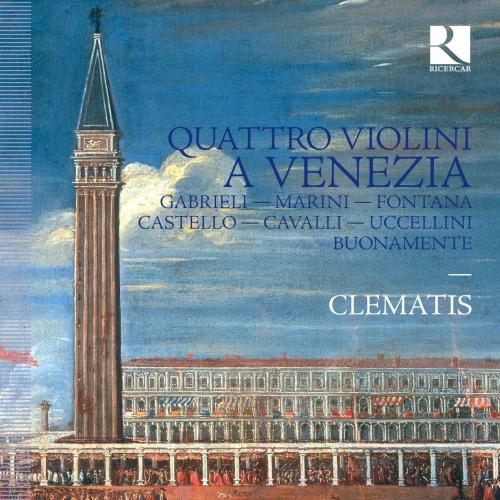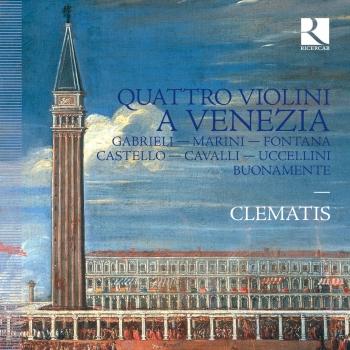
Quattro violoni a Venezia Clematis
Album Info
Album Veröffentlichung:
2019
HRA-Veröffentlichung:
06.09.2019
Label: Ricercar
Genre: Classical
Subgenre: Chamber Music
Interpret: Clematis
Komponist: Pier Francesco Cavalli (1602-1676), Marco Uccellini (1610-1680), Giovanni Gabrieli (1557-1612), Salomone Rossi (1570-1930), Biagio Marini (1597-1665), Dario Castello (1600-1658), Giovanni Battista Fontana (1571-1631)
Das Album enthält Albumcover
- Marco Uccellini (1603 - 1680):
- 1 Sinfonia decima settima a quatro violini 03:02
- Giovanni Gabrieli (1557 - 1612):
- 2 Canzon II a 6 04:03
- Biagio Marini (1594 - 1663):
- 3 Sonata quarta per sonar con due corde 07:44
- Salomone Rossi (1570 - 1630):
- 4 Sinfonia a 5 & a 3 si placet 01:39
- 5 Sonata a quattro violini e doi chitarroni 03:39
- Giovanni Gabrieli:
- 6 Sonata XXI con tre violini 04:41
- Biagio Marini:
- 7 Sonata in Ecco con tre violini 05:19
- 8 Canzon prima per quattro violini 03:02
- Giovanni Battista Buonamente (1595 - 1642):
- 9 Sonata prima a quattro violini 06:19
- 10 Sonata 16 a tre violini 05:21
- Dario Castello (1602 - 1631):
- 11 Sonata decima settima in Ecco 07:51
- Biagio Marini:
- 12 Capriccio per sonare il violino con tre corde a modo di lira 02:51
- Marco Uccellini:
- 13 Sinfonia decima nona a tre violini 02:43
- Francesco Cavalli (1602 - 1676):
- 14 Canzon a 3, 2 violini e violoncino 06:18
Info zu Quattro violoni a Venezia
Venezianische Spezialität: Obwohl die ersten Geigenvirtuosen hauptsächlich aus Cremona, Brescia oder Mantua kamen, war es Venedig, das sich rasch als bedeutendstes Zentrum für die Entwicklung der Instrumentalmusik herausstellte. Venedig war auch die Stadt, wo das gesamte 17. Jahrhundert hindurch die meisten Sammlungen dieses Genres gedruckt wurden. Es ist merkwürdig, dass alle diese Virtuosen offensichtlich gerne ihren Erfolg mit ihren Kollegen teilten: Denn neben Werken für eine oder zwei Violinen und Continuo, schrieben fast alle, auf dieser CD versammelten Komponisten-Violinisten, Sonaten, Canzone oder Sinfonien, die für Ensembles von drei oder vier Violinen vorgesehen waren. Darüber hinaus finden sich in diesen Kompositionen oft doppelchörige oder auch Echo-Effekte. All das geschah im Zuge der Entdeckung der für die Barockzeit so charakteristischen Virtuosität. Diese Entwicklung führte zu vielen neuen Effekten, wie z.B. dem Doppelgriff oder der Toccata ähnelnden, virtuosen Läufen, mit denen die Instrumentalisten auf ihre Kunstfertigkeit aufmerksam machten.
Clematis
Stephanie de Failly, Leitung
Brice Sailly, Leitung
Ensemble Clematis
The Clematis is a sweet-smelling flower that represents the principles of idealism and of creativity. Such a name for an ensemble specialising in baroque music is more than justified, for it is creative in that this repertoire can only live if it receives an interpretation based on inspiration and renewal; it is idealistic in that such creative inspiration must of necessity be based on a great respect for the work as it appears in its original sources.
The violinist Stéphanie de Failly founded Clematis in 2001 with the intention of concentrating on the lesser-known repertoire of the 17th century. The ensemble performs extensively from the Italian repertoire of the period as well as French and German works, although with a particular interest in the forgotten works of such composers from the Low Countries of the time as Nicolaus à Kempis, Carolus Hacquart and Giuseppe Zamponi. Clematis also made a performing version and gave the first performance in modern times of Zamponi’s opera Ulisse nell isola di Circe, complete with a splendid cast of singers; the opera had first been given in Brussels in 1650.
The number of musicians involved with Clematis varies in number, as they are chosen in relation to the needs of the works being performed at any given moment; its musicians are all actively engaged with leading baroque ensembles throughout Europe. The ensemble’s desire for historical authenticity leads it to work closely with musicologists so that its programmes can be as close to the original sources as possible. Clematis appears not only in Belgium but also performs frequently abroad: it has so far appeared in the Netherlands, France, Israël, Italy, Spain, Poland, Bolivia, Mexico and Russia.
Clematis’ is very much concerned with Italian instrumental music of the 17th century, and in particular with the development of the violin repertoire; this can be seen in their recordings of works by Carlo Farina, Giovanni Battista and Tomaso Antonio Vitali. Their most recent CD is devoted to the works of Giovanni Legrenzi and was released in May 2016.
Another of Clematis’ concerns is German sacred and instrumental music from the beginning of the 17th century to the first works of J.S. Bach. Such programmes of vocal music clearly require superb soloists such as Mariana Flores, Juliette Perret, Deborah Cachet, Paulin Bündgen, Zachary Wilder, Philippe Favette and others.
Clematis also collaborates regularly with the various other ensembles led by Leonardo Garcia Alarcon, including the Capella Mediterranea and the Chamber Choir of Namur; this was also the case for the recording devoted to the secular works of Mattheo Romero and to CARMINA LATINA, a collection of baroque music from Latin America.
Clematis has made many recordings; its output has only benefited from the enthusiastic reports it has received from distinguished critics.
Dieses Album enthält kein Booklet











